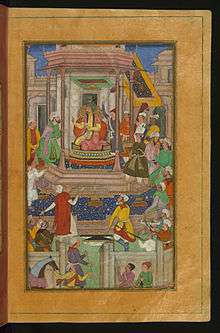Ghazni
Ghazni (Pashto/Persian: غزني) historically known as Ghaznin (غزنين) or Ghazna (غزنه), is a city in central Afghanistan with a population of around 270,000 people. The city is strategically located along Highway 1, which has served as the main road between Kabul and Kandahar for thousands of years. Situated on a plateau at 2,219 metres (7,280 ft) above sea level, the city is 150 km south of Kabul and is the capital of Ghazni Province.
Ghazni غزني | |
|---|---|
City | |
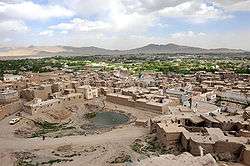 Sky View of Ghazni | |
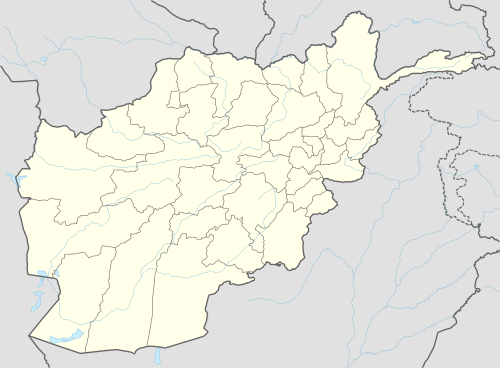 Ghazni Location in Afghanistan | |
| Coordinates: 33°32′57″N 68°25′24″E | |
| Country | |
| Province | Ghazni Province |
| District | Ghazni District |
| Elevation | 2,219 m (7,280 ft) |
| Population (2019) | |
| • Total | 270,000 |
| Time zone | UTC+4:30 (AST) |
Ghazni (the name meaning jewel) is an ancient city with a rich history. Ghazni Citadel, the Minarets of Ghazni, the Palace of Sultan Mas'ud III and several other cultural heritage sites have brought travellers and archeologists to the city for centuries, and in 2013, ISESCO declared Ghazni the year's Islamic Capital of Culture. During the pre-Islamic period, the area was inhabited by various tribes who practiced different religions including Buddhism and Hinduism.[1] Arab Muslims introduced Islam to Ghazni in the 7th century and were followed in the 9th century by the Saffarids. Sabuktigin made Ghazni the capital of the Ghaznavid Empire in the 10th century. The city was destroyed by one of the Ghurid rulers, but later rebuilt. It fell to a number of regional powers, including the Timurids and the Delhi Sultanate, until it became part of the Hotaki dynasty, which was followed by the Durrani Empire or modern Afghanistan.
During the First Anglo-Afghan War in the 19th century, Ghazni was partially destroyed by British-Indian forces.
The city is currently being rebuilt by the Government of Afghanistan in remembrance of the Ghaznavid and Timurid era when it served as a major center of Islamic civilisation.[2] The Afghan National Security Forces (ANSF) have established bases and check-points to deal with the Taliban insurgency but in August 2018 the city became of the site of the Battle of Ghazni with the Taliban briefly occupying it and taking control of most of the surrounding area.
Ghazni is a trading and transit hub in central Afghanistan. Agriculture is the dominant land use at 28%.[3] In terms of built-up land area, vacant plots (33%) slightly outweigh residential area (31%).[3] Districts 3 and 4 also have large institutional areas. The city of Ghazni's population surged from 143,379 in 2015[4] to 270,000 in 2018 as refugees from violent areas fled to the city.[5] The city has four police districts (nahia) and covers a total land area of 3,330 hectares.[3] The total number of dwellings in Ghazni city is 15,931.[3]
In 2013, ISESCO declared Ghazni the year's Islamic Capital of Culture.[6]
History
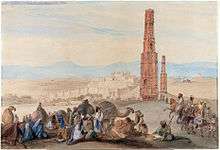
The city was founded some time in antiquity as a small market town. It may be the Gazaca (Gázaca or Gāzaca) mentioned by Ptolemy,[7] although he may have conflated it and the town of Ganzak (or Gazaka) in Iran.
In the 6th century BC, it was conquered by the Achaemenid king Cyrus II and incorporated into the Persian empire. The city was subsequently incorporated into the empire of Alexander the Great in 329 BC, and called Alexandria in Opiana. By the 7th century AD, the area was a major centre of Buddhism. In 644, the Chinese pilgrim Xuanzang visited a city named Jaguda—which was almost certainly the contemporary name of the later Ghazni – while returning from Varnu (modern Bannu, Pakistan)—and as he crossed the land of a people he called O-po-kien (Afghans/Pashtuns).[8][9]
In 683, Arab armies brought Islam to the region. Yaqub Saffari from Zaranj conquered the city in the late 9th century. The Saffarids reduced the formerly Hindu Lawik dynasty to a tributary status. In 962, the Turkic slave commander of the Samanid Empire, Alp-Tegin, attacked the city and besieged the Citadel of Ghazni for four months, wresting the city from Abu Bakr Lawik.[10] Around 965, Abu Bakr Lawik recaptured Ghazni from Alp-Tegin's son, Abu Ishaq Ibrahim, forcing him to flee to Bukhara. However, this was not to last long because Abu Ishaq Ibrahim shortly returned to the town with Samanid aid, and took control of the town once again. For nearly two hundred years (977–1163), the city was the dazzling capital of the Ghaznavid Empire, which encompassed much of what is today Afghanistan, Turkmenistan, Pakistan, Eastern Iran and Rajasthan. The Ghaznavids took Islam to India and returned with fabulous riches taken from Indian princes and temples. Although the city was sacked in 1151 by the Ghorid Ala'uddin, it became their secondary capital in 1173, and subsequently flourished once again. Between 1215 and 1221, Ghazni was ruled by the Khwarezmid Empire, during which time it was destroyed by the Mongol armies of Genghis Khan's son Ögedei Khan.[11]
In the first decades of the 11th century, Ghazni was the most important centre of Persian literature. This was the result of the cultural policy of the Sultan Mahmud (reigned 998–1030), who assembled a circle of scholars, philosophers, and poets around his throne in support of his claim to royal status in Iran.[12]
The noted Moroccan travelling scholar, Ibn Battuta, visiting Ghazni in 1333, wrote:
"We travelled thence to Parwan, where I met the amir Buruntayh. He treated me well and wrote to his representatives at Ghazna enjoining them to show me honour. We went on to the village of Charkh [Charikar], it being now summer, and from there to the town of Ghazna. This is the town of the famous warrior-sultan Mahmud ibn Sabuktagin, one of the greatest of rulers, who made frequent raids into India and captured cities and fortresses there. His grave is in this city and is surmounted by a hospice. The greater part of the town is in ruins and nothing but a fraction of it remains, though it was once a large city. It has an exceedingly cold climate, and the inhabitants move from it in the cold season to Qandahar, a large and prosperous town three nights journey from Ghazna, but I did not visit it."[13]
Tamerlanes's grandson, Pir Muhammad bin Djinhangir, became the governor of Ghazni (along with Kabul and Kandahar) in 1401. Babur conquered the region in 1504 and personally thought that Ghanzi was "a mean place" and pondered why any of the princes of the region would make it their seat of government. Ghazni stayed under Mughal control until 1738 when Iranian ruler Nader Shah invaded the area. After Nader Shah's death, Ghazni became part of the Durrani empire.[14]
-_Menschen_-_Annemarie_Schwarzenbach_-_SLA-Schwarzenbach-A-5-21-155.jpg)
-_Stadtansicht_-_Annemarie_Schwarzenbach_-_SLA-Schwarzenbach-A-5-21-170.jpg)
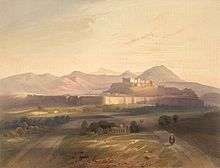
Ghazni City is famous for its Ghazni Minarets built on a stellar plan. They date from the middle of the twelfth century and are the surviving elements of the mosque of Bahramshah. Their sides are decorated with intricate geometric patterns. Some of the upper sections of the minarets have been damaged or destroyed. The most important mausoleum located in Ghazni City is that of Sultan Mahmud. Others include the Tombs of poets and scientists, such as the Tomb of Al Biruni. The only ruins in Old Ghazni retaining a semblance of architectural form are two towers, about 43 m (140 ft) high and 365 m (1,200 ft) apart. According to inscriptions, the towers were constructed by Mahmud of Ghazni and his son. For more than eight centuries the “Towers of Victory” monuments to Afghanistan's greatest empire have survived wars and invasions, the two toffee-colored minarets, adorned with terra-cotta tiles were raised in the early 12th century as monuments to the victories of the Afghan armies that built the empire. By the time the Ghurids had finalized the Ghaznavid removal from Ghazni, the city was a cultural center of the eastern Islamic world.[15]
The Buddhist site at Ghazni is known as Tapar Sardar and consists of a stupa on a hilltop, surrounded by a row of smaller stupas.[14] Nearby, an 18-metre (59 ft) long Parinirvana (reclining) Buddha was excavated between the late 1960s and early 1970s. It is believed to have been built in the 8th Century AD as part of a monastery complex.[16] In the 1980s, a mud brick shelter was created to protect the sculpture, but the wood supports were stolen for firewood and the shelter partially collapsed. In 2001, the Taliban blew the Buddha up, believing it to be idolatrous.[17]
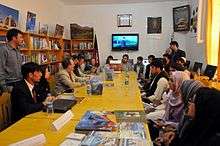
During the First Anglo-Afghan War, the city was stormed and taken over by the British forces on 23 July 1839 in the Battle of Ghazni. The Civil war in Afghanistan and the continued conflict between the Taliban and the Northern Alliance during the 1990s put the relics of Ghazni in jeopardy. Ghazni's strategic position, both economically and militarily, assured its revival, albeit without its dazzling former grandeur. Through the centuries the city has figured prominently as the all-important key to the possession of Kabul.
After the 2001 invasion of Afghanistan, the United States armed forces built a base in Ghazni. They have been involved in rebuilding projects and protecting the local population against Taliban insurgents. In the meantime, they are also training the Afghan Local Police (ALP) Afghan National Police (ANP) and Afghan National Army (ANA). In 2010, the United States established the Lincoln Learning Center in Ghazni.[18] The Lincoln learning centers in Afghanistan serve as programming platforms offering English language classes, library facilities, programming venues, Internet connectivity, educational and other counseling services. A goal of the program is to reach at least 4,000 Afghan citizens per month per location.[19]
On 10 August 2018, the city was attacked by the Taliban during the Battle of Ghazni. Dozens of airstrikes were carried out in support of Afghan police and government forces and hundreds of Afghan soldiers, police, and Taliban insurgents were killed as well as dozens of civilians. In addition to the destruction and human suffering caused by the fighting, the Taliban also set fire to many buildings in the city.
On 18 May 2020, a suicide Humvee bomber affiliated with the Taliban killed nine Afghan intelligence personnel and injured 40 others at the National Directorate of Security (NDS) unit in Ghazni, also damaging the nearby Islamic Cultural Centre.[20][20][21][22]
Climate
Ghazni's climate is transitional between cold semi-arid climate (Köppen climate classification BSk) and warm-summer humid continental climate (Dsa). It has cold, snowy winters and warm, dry summers. Precipitation is low and mostly falls in winter (when it mostly falls as snow) and spring.
| Climate data for Ghazni | |||||||||||||
|---|---|---|---|---|---|---|---|---|---|---|---|---|---|
| Month | Jan | Feb | Mar | Apr | May | Jun | Jul | Aug | Sep | Oct | Nov | Dec | Year |
| Record high °C (°F) | 16.0 (60.8) |
17.8 (64.0) |
24.8 (76.6) |
28.0 (82.4) |
33.0 (91.4) |
36.3 (97.3) |
36.7 (98.1) |
35.6 (96.1) |
32.5 (90.5) |
29.9 (85.8) |
21.2 (70.2) |
16.6 (61.9) |
36.7 (98.1) |
| Average high °C (°F) | 0.6 (33.1) |
2.3 (36.1) |
10.0 (50.0) |
18.0 (64.4) |
23.7 (74.7) |
29.2 (84.6) |
30.8 (87.4) |
30.5 (86.9) |
26.5 (79.7) |
19.0 (66.2) |
12.6 (54.7) |
5.4 (41.7) |
17.4 (63.3) |
| Daily mean °C (°F) | −5.9 (21.4) |
−4.4 (24.1) |
3.8 (38.8) |
11.0 (51.8) |
16.3 (61.3) |
21.4 (70.5) |
23.3 (73.9) |
22.2 (72.0) |
16.9 (62.4) |
10.3 (50.5) |
4.0 (39.2) |
−1.8 (28.8) |
9.8 (49.6) |
| Average low °C (°F) | −10.6 (12.9) |
−9.0 (15.8) |
−1.5 (29.3) |
4.2 (39.6) |
8.1 (46.6) |
12.4 (54.3) |
15.1 (59.2) |
14.1 (57.4) |
8.3 (46.9) |
2.2 (36.0) |
−2.5 (27.5) |
−6.6 (20.1) |
2.8 (37.1) |
| Record low °C (°F) | −33.5 (−28.3) |
−29.2 (−20.6) |
−17.5 (0.5) |
−5.8 (21.6) |
0.0 (32.0) |
5.0 (41.0) |
7.7 (45.9) |
2.0 (35.6) |
−3.5 (25.7) |
−6.0 (21.2) |
−13.8 (7.2) |
−33.2 (−27.8) |
−33.5 (−28.3) |
| Average precipitation mm (inches) | 40.2 (1.58) |
53.9 (2.12) |
70.9 (2.79) |
49.9 (1.96) |
19.7 (0.78) |
1.9 (0.07) |
14.1 (0.56) |
4.7 (0.19) |
0.5 (0.02) |
4.1 (0.16) |
11.3 (0.44) |
25.8 (1.02) |
297 (11.69) |
| Average rainy days | 1 | 2 | 7 | 9 | 6 | 1 | 3 | 2 | 0 | 1 | 2 | 1 | 35 |
| Average snowy days | 6 | 7 | 4 | 1 | 0 | 0 | 0 | 0 | 0 | 0 | 1 | 5 | 24 |
| Average relative humidity (%) | 68 | 72 | 64 | 55 | 43 | 36 | 43 | 39 | 35 | 42 | 52 | 60 | 51 |
| Mean monthly sunshine hours | 175.3 | 174.8 | 227.6 | 258.6 | 314.3 | 346.2 | 353.2 | 341.8 | 324.5 | 293.9 | 256.4 | 194.6 | 3,261.2 |
| Source: NOAA (1958–1983)[23] | |||||||||||||
Demography

The city of Ghazni's population surged from 143,379 in 2015[4] to 270,000 in 2018 as refugees from violent areas fled to the city.[5] In 2015, there were 15,931 dwellings in Ghazni city.[3]
The population is multi-ethnic, with approximately 50% being Tajik, 25% Pashtun, 20% Hazara, and 5% Hindus.[24][25]
Infrastructure


Transportation
In April 2012, Ghazni Governor Musa Khan Akbarzada laid the foundation stone of the Ghazni Airport. The work began later that year and was supervised by the managing director of the Ghazni province Engineer Ahmad Wali Tawakuli.[26]
The city is next to Afghanistan's main highway that runs between Kabul and Kandahar in the south. There are roads leading to Gardez and in the east and other nearby villages as well as to towns in Hazarajat in the northwest.
Education
The city has a number of public schools. Jahan Maleeka School is an all-girls school with over 5,000 students and 150 teachers. Naswan Shaher Kohna School, another all-girls school, has over 3000 students.
Resources
Ghazni City is in an area of low rainfall. In 2007, one of the gates on a 50-year-old dam on the Jikhai River broke, bringing up concerns among the inhabitants of Ghazni city about the water supply. The dam serves as a good source of irrigation water to Ghazni City and the surrounding agricultural areas.[27][28] Nearby rivers have a history of flooding and causing severe damage and death,[29] though efforts have begun to remedy this.[30]
Notable people
- Abu Bakr Lawik
- Abu Ali Lawik
- Ali Hujwiri Data Ganj Bakhsh
- Jamal al-Din al-Ghaznawi
- Hassan Ghaznavi
- Mahmud of Ghazni
- Azad Khan Afghan
- Nur Muhammad Taraki
- Faiz Mohammad Katib Hazara
- Abdul Ahad Mohmand
- Hakim Sanai, Persian Sufi poet and mystic
- Muhammad Shah
- Bhai Nand Lal, Court Poet of Guru Gobind Singh, 10th Sikh Guru
Points of interest
- Citadel of Ghazni
- Minarets of Ghazni
- Palace of Sultan Mas'ud III
- Tomb of Sebuktigin
- Mausoleum of Sultan Mahmud
- Mausoleum of Sanai
- Museum of Islamic Art
- Tapa Sardar Excavations
Twin towns – sister cities
See also
References and footnotes
- Richards, J.F. (1974). "The Islamic frontier in the east: Expansion into South Asia". Journal of South Asian Studies. 4 (1): 91–109. doi:10.1080/00856407408730690.
- Saifullah Mafto, ed. (June 13, 2012). "Work on Ghazni Islamic Culture Centre starts". Pajhwok Afghan News (PAN). Archived from the original on June 3, 2013. Retrieved 2012-06-13.
- The State of Afghan Cities Report 2015. Archived from the original on 31 October 2015. Retrieved 20 October 2015.
- The State of Afghan Cities Report 2015. Archived from the original on 31 October 2015. Retrieved 21 October 2015.
- Afghan City Gauges Toll After Taliban Siege . Wall Street Journal.
- "Ghazni To Be Islamic Capital Of Culture". RadioFreeEurope/RadioLiberty. Retrieved 31 March 2018.
- Guinta, Roberta. "GAZNÈ (or GÚazna, GÚazn^n)". Encyclopædia Iranica (Online ed.). United States: Columbia University. Retrieved January 2008. Check date values in:
|accessdate=(help) - BA Litvinsky, Zhang Guand-Da, R. Shabani Samghabadi, History of civilizations of Central Asia, pg. 385
- Hui-li, 1959, p. 188
- John Andrew Boyle (1968). The Cambridge History of Iran, Volume 5. Cambridge University Press. p. 165. ISBN 9780521069366.
- "Ghazni". The Columbia Electronic Encyclopedia, 6th ed. Copyright © 2007, Columbia University Press.
- Encyclopædia Britannica: Persian literature, retrieved
- Ibn Battuta (2004). Travels in Asia and Africa, 1325–1354 (reprint, illustrated ed.). London: Routledge. p. 179. ISBN 9780415344739. Retrieved 2010-09-10.
- Trudy Ring, Robert M. Salkin, Sharon La Boda (1996) International Dictionary of Historic Places: Asia and Oceania v.5, P. 279-282. Taylor & Francis, ISBN 1-884964-04-4
- C.E. Bosworth, The Later Ghaznavids, (Columbia University Press, 1977), 115.
- A note on the Parinirvana Buddha at Tapar Sardar M. Taddei (1974) South Asian archaeology 1973: papers from the second International Conference of the Association for the Promotion of South Asian Archaeology in Western Europe, Brill Archive, ISBN 90-04-04189-3
- Afghan Buddha destruction revealed 15/03/01 BBC News Site
- "Ghazni governor signs memorandum for Lincoln Learning Center - War On Terror News". waronterrornews.typepad.com. Retrieved 31 March 2018.
- https://photos.state.gov/libraries/afghanistan/231771/PDFs/RFP-Lincoln-Learning-Centers.pdf
- "Taliban suicide bomber kills 9 troops in eastern Afghanistan". May 18, 2020 – via www.washingtonpost.com/.
- "At least 7 killed in Taliban attack in Afghanistan's Ghazni". May 18, 2020 – via www.xinhuanet.com/.
- "Official: Suicide Bomber in Eastern Afghanistan Kills 5". May 18, 2020 – via www.nytimes.com/.
- "Ghazni Climate Normals 1958-1983". National Oceanic and Atmospheric Administration. Retrieved February 17, 2013.
- "UNHCR Sub-Office Central Region, District Profile" (PDF). Archived from the original (PDF) on 2007-09-28. Retrieved 2007-07-15.
- "2003 National Geographic Population Map" (PDF). Thomas Gouttierre, Center For Afghanistan Studies, University of Nebraska at Omaha; Matthew S. Baker, Stratfor. National Geographic Society. 2003. Retrieved 2011-04-11.
- Mirwais Himmat, ed. (April 11, 2012). "Ghazni to have first-ever international airport". Pajhwok Afghan News (PAN). Retrieved 2012-06-08.
- "Ghazni's Zanakhan Dam damaged". Archived from the original on 2007-09-27. Retrieved 2007-07-15.
- Heavy water flow damages Ghazni's Zanakhan Dam Mar 15 2007, Pajhwok Afghan News
- "Dam burst swamps Ghazni city of Afghanistan". Pakistan Times. Retrieved 2007-07-15.
- "Ghazni". GlobalSecurity.org. Retrieved 2007-07-15.
- Sister Cities International Archived 2008-10-07 at the Wayback Machine
- Co Giżycko łączy z Ghazni? Archived 2013-11-11 at the Wayback Machine
Further reading
- Published in the 19th century
- G. T. Vigne (1843). "Ghuzni". A Personal Narrative of a Visit to Ghuzni, Kabul and Afghanistan (2nd ed.). London: G. Routledge. OCLC 6388460.
- Edward Balfour (1885). "Ghazni". Cyclopaedia of India (3rd ed.). London: B. Quaritch.
- Published in the 20th century
- . Encyclopædia Britannica. 11 (11th ed.). 1911. pp. 917–918.
- Published in the 21st century
- C. Edmund Bosworth, ed. (2007). "Ghazna". Historic Cities of the Islamic World. Leiden: Koninklijke Brill.
- "Ghazna". Grove Encyclopedia of Islamic Art & Architecture. Oxford University Press. 2009.
External links
| Wikimedia Commons has media related to Ghazni. |
- Map of Ghazni district
- Ghazni.info
- Ghazni.org
- 1911 encyclopedia entry
- The City Of Ghazni at the Wayback Machine (archived March 13, 2008)
- "Ghazni". Islamic Cultural Heritage Database. Istanbul: Organisation of Islamic Cooperation, Research Centre for Islamic History, Art and Culture. Archived from the original on 2013-06-15.
- ArchNet.org. "Ghazni". Cambridge, Massachusetts, USA: MIT School of Architecture and Planning. Archived from the original on 2008-05-05.
| Preceded by Samarkand |
Capital of Khwarazmian Empire (Persia) 1220–1221 |
Succeeded by Tabriz |

